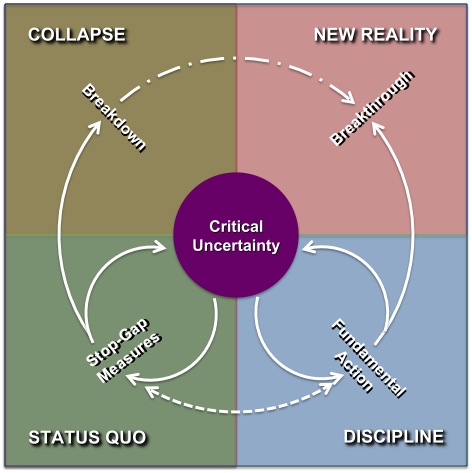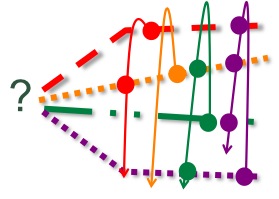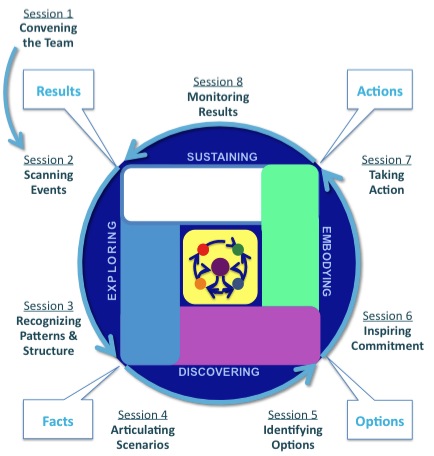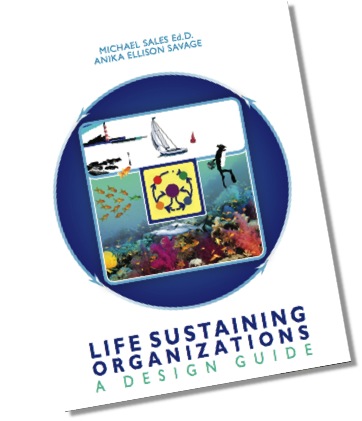Structural Dynamics
Moving into the Future with Confidence

Structural Dynamics is a strategic process that Convenes a team of strategic thinkers who move through four phases:
– Discovering
– Embodying
– Sustaining
Revelations in one area could lead forward or may lead back to a previous space to revise, expand and/or deepen the thinking. Here’s a quick look at these steps.
Convening
The organization determines the need for a strategic initiative that is as dynamic as its environment. The team is comprised of strategic thinkers from all levels and parts of the organization, and may include customers, suppliers and others who care deeply about the organization’s health and success. A diversity of knowledge, views and opinion sparks the process, stretches thinking and strengthens the outcomes. The team's first task is to consider what brought them together. They frame the strategic issue that will keep the process focused.
The team gathers to consider the issue. They explore beneath the surface of events to understand the patterns, structure and mental models underlying these events.

Events – Drawing upon their own knowledge, that of their constituents and reliable sources, the team identifies the many external events, which, if they occurred, would have a significant impact
on the focal issue. What’s going on and what might happen? Which of these events are inevitable? Which are highly uncertain? Which are critical to the issue at hand?
Patterns – The team determines how the most critical and the most uncertain events and variables have been trending over time. They recognize patterns by determining what is causing these trends and what these trends are impacting.
Structure – The team depicts the cause and effect relationships between these factors – what each impacts and what it is impacted by. This system of interconnected patterns reveals the underlining structure driving events.
Myths & Metaphors – The team realizes that our cultural and cognitive filters affect what we see and how we see it. These filters impact which factors we place in the model and the causal relations that we recognize between these factors. Careful consideration and strategic conversation can help to recognize these mental models and arrive at a shared vision.
The GAME BOARDTM:

The structural model that the team develops represents the facts driving the system. We call it a Game Board because validates multiple points of view and lets strategic thinkers experience a wide range of possible future condistions in order to test their assumptions and mental models.
The Game Board is the heart of the Structural Dynamics process. The forces depicted in the system are durable, they existed in the past, persist in the present and are likely to endure in the future. With this broad range of future possibilities represented as four archetypal scenarios, the team is ready to Discover the organizations strategic options.
Throughout the Structural Dynamics initiative, the team is continually communicating within the organization – upward, downward and sideways – seeking both feedback and support.

Scenarios – The team articulates a set of distinct, plausible images of the future based on the structure they have laid out in the Game Board for several critical uncertainties. These scenarios include social, economic, technical, political, aesthetic and environmental conditions.
Strategies – For each scenario, the team “lives” in that future long enough to discover the most effective action for the organization to take in that set of conditions. The strategies devised for each of the scenarios are stress-tested to see how they work in the other scenarios. Strategies that which work well [often for very different reasons] in a wide range of future conditions are “robust” – others may be contingent on a particular set of conditions occuring. The team also stress tests any existing strategies that the organization is considering or implementing.The most robust strategies and some contingency plans become the strategic direction of the organization. The organization is prepared to move forward with confidence. It’s options have been determined and the choice is clear. So let’s go!
Action Plans – To ensure that they are aligned and moving in the same direction, the components of the organization adapt the organizational strategies to their own domains. They do not develop plans that simply optimize their own performance: they must act in concert with the whole.
Signposts, Warnings and Indicators – The team prepares to track events and the impact of the organization’s strategic actions. They determine what to measure to encourage and assess results; and which signposts, warnings and indicators to monitor to keep tabs on changes in the external environment and internal results.

We lay out the Structural Dynamics process and its connection to life-sustaining organizations and anticipatory leaders in much more detail in our book.
Check below


